
AIA New York Chapter issues statement praising "a good start," raising concerns
Site plans released July 16 for the World Trade Center have become a subject of much debate in New York City and across the country as the victims' families, public officials, architects, planners, and private citizens react to the six proposals by Beyer Blinder Belle and its partners. Representatives from the Lower Manhattan Development Corporation and the Port Authority of New York and New Jersey heard from more than 4,000 people who attended the "Listening to the City" meetings in New York City on Saturday and Sunday. In this spirit, AIArchitect is sharing what AIA New York as well as our colleagues have to say about the proposed plans for the development of Lower Manhattan.
AIA New York Chapter
Issues Public Statement Concerning Six Concept Plans
Following is the press release issued by AIA New York Chapter on July
16.
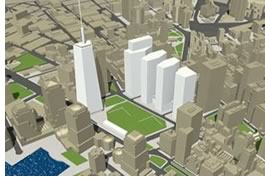 The
six urban design approaches and concept plans presented this morning by
the Lower Manhattan Development Corporation and the Port Authority represent
a very good starting point for public discussion about the rebuilding
process. The New York Chapter of The American Institute of Architects,
representing more than 3,000 architects working in our city, has participated
in these discussions since last October as a founding participant in New
York New Visions, a pro bono coalition of 21 architecture, engineering,
planning, and design organizations. The AIA New York Chapter recognizes
the extraordinary effort that went into the preparation and explanation
of the six options that indicate significantly different ways of looking
at the memorial to those who perished on September 11 at the World Trade
Center.
The
six urban design approaches and concept plans presented this morning by
the Lower Manhattan Development Corporation and the Port Authority represent
a very good starting point for public discussion about the rebuilding
process. The New York Chapter of The American Institute of Architects,
representing more than 3,000 architects working in our city, has participated
in these discussions since last October as a founding participant in New
York New Visions, a pro bono coalition of 21 architecture, engineering,
planning, and design organizations. The AIA New York Chapter recognizes
the extraordinary effort that went into the preparation and explanation
of the six options that indicate significantly different ways of looking
at the memorial to those who perished on September 11 at the World Trade
Center.
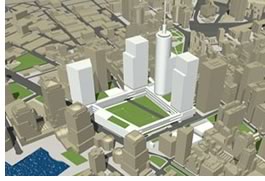 Questions
raised by New York New Visions in regard to the six options include
Questions
raised by New York New Visions in regard to the six options include
1. Is the program of 11 million square feet of office space and 600,000
square feet of commercial space based on a comprehensive economic and
land use analysis?
2. Is each concept site plan integrated with coordinated transportation
plans and needs?
3. How does each concept plan integrate with the neighborhood, with Manhattan,
and with the region? Are these truly comprehensive master plans?
4. How does each concept plan integrate with the memorial process?
5. Did the architects and planners working with the Port Authority and
LMDC consider a sufficiently broad range of urban planning solutions?
Are there really six schemes or is there one scheme with six variations?
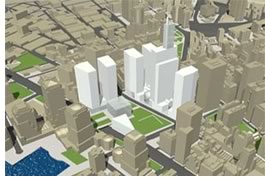 These
are not merely rhetorical questions but suggest areas of further discussion
and analysis. The differences among the six options are truly significant
in regard to aspects of surface transportation, vehicular and pedestrian
movement, and the disposition of open space on the 16-acre site. This
is commendable given the importance of these plan elements and the statement
made that such design components are potentially interchangeable elements
leading to other schemes with different configurations.
These
are not merely rhetorical questions but suggest areas of further discussion
and analysis. The differences among the six options are truly significant
in regard to aspects of surface transportation, vehicular and pedestrian
movement, and the disposition of open space on the 16-acre site. This
is commendable given the importance of these plan elements and the statement
made that such design components are potentially interchangeable elements
leading to other schemes with different configurations.
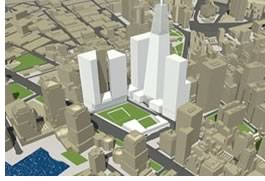 Significant
elements, however, are missing from the options. Missing from all six
concept plans are significant variations in the location of intermodal
public transportation connections. Missing from all six options is consideration
of on-site location of housing. Missing from all six approaches is the
recognition that building less than 11 million square feet of office space
on the site is justifiable both from an urban design perspective as well
as from that of a qualitative approach to building design.
Significant
elements, however, are missing from the options. Missing from all six
concept plans are significant variations in the location of intermodal
public transportation connections. Missing from all six options is consideration
of on-site location of housing. Missing from all six approaches is the
recognition that building less than 11 million square feet of office space
on the site is justifiable both from an urban design perspective as well
as from that of a qualitative approach to building design.
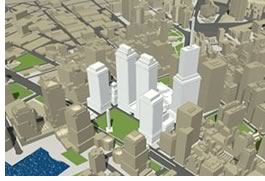 There
are important differences among the plans that provide a basis for ongoing
discussion and development of the core ideas. The questions raised are
as meaningful in this regard as are the answers:
There
are important differences among the plans that provide a basis for ongoing
discussion and development of the core ideas. The questions raised are
as meaningful in this regard as are the answers:
• Why not more vehicular streets?
• Why not consider building commercial office space above West Street?
• Why not show housing as part of a mixed-use development on-site?
• Does the memorial location become an isolated parcel or is it incorporated
in the site planning?
• Are pedestrian streets intended for daytime shoppers or for enhancement
of the 24-hour, 7-day urban vitality stressed in the LMDC Blueprint?
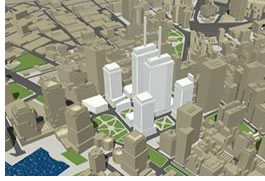 These
questions and others suggest that a lively public discussion will occur
at the "Listening to the City" special town hall meeting which
was held on July 20 at the Javits Center. But, as importantly, they indicate
that the public participation in the planning process does not begin and
end with a town hall meeting. Continuing input on economic development
issues, urban design quality, building height, and site coverage is essential
and can offer additional options.
These
questions and others suggest that a lively public discussion will occur
at the "Listening to the City" special town hall meeting which
was held on July 20 at the Javits Center. But, as importantly, they indicate
that the public participation in the planning process does not begin and
end with a town hall meeting. Continuing input on economic development
issues, urban design quality, building height, and site coverage is essential
and can offer additional options.
We call upon the Port Authority, the LMDC, and their professional advisors to continue their commendable efforts and produce additional concepts and approaches that respond to these concerns.
Emails
from your colleagues:
AIA Architects respond to WTC
site designs.
1. I feel confident that whatever actually replaces the twin towers will be wonderful. However, as a non-New Yorker, I can't help but wish the twin towers would be rebuilt. I understand that the families would love the entire site to be dedicated as a memorial to their loved ones, but that is unrealistic and I think in some ways admitting defeat. A true memorial is a vibrant working, living site that contributes to the life of New York and America. I also understand the reluctance to build back the 110-story buildings. Who is going to want to occupy the top floors? Yet I can't help but believe everyone would love to see the towers back on the skyline. Why couldn't the frame of the building in their original size and shape be built back—even if the upper floors are but an open frame which are not occupied. Maybe that could be the memorial, instead of something on the ground. I just wanted to share my ideas. Maybe you can pass them along.
2. These are very sad—we are letting the terrorist win. None of these proposals comes close to replacing what we had. Whatever is built should be a statement expressing excellent design and the strength of a great nation. The whole world is waiting and watching to see us climb out of the hole and make a statement. This is an opportunity to replace a great piece of architecture with an even greater one. Why are we wimping out? I am embarrassed!!!
3. Thanks for publishing the WTC schemes in a simple, easy-to-access manner. Unfortunately the visions lack that.
The loss of these towers demonstrates the true power of Architecture to affect the human psyche. The AIA needs to push for an international competition to create the kind of enlightened solution the American people deserve! The program can include, among other things, all of the office space as was in the towers and the memorial. They should pick one winner. And build it!
Otherwise, they will continue to be mired in the mediocre planning du jour and the self-interest of the local parties. Maybe they can announce the competition on 9/11/02. If they can accomplish that much after a year, all is not lost. But that's just my opinion. Why don't you survey my colleagues?
4. I heard something way different on the news: that the public at large is offended by these six lame schemes. I tend to agree this most severe rebuild needs to go through the proper competition phases for a successful project.
This type of predestined firm approach is only a major slap in all of our faces. I hope the WTC site never gets rebuilt if this is the architectural community's response to terrorism. This is completely sick, and I believe it is the responsibility of not only the AIA, but also every member to speak out against such a poor massing of six non-sensitive ideas.
This only proves that from an architectural standpoint we are weak and that terrorism will not allow us to build to the stars. I say rebuild taller and stronger, 200 stories at over 2,000 feet. The memorial only exists if it yells out "NO" to any defeat of America!
As a member, I say no and you can put my signature first on an affidavit that demands a fair and legal competition for what the public wants: more! And you and I know it.
5. As an architect and a member of the AIA living and practicing in Florida, I have been following, with great interest, the reports and stories surrounding the proposed design(s) for the site formerly occupied by the World Trade Center (WTC) complex. Having visited the twin towers with my wife in both 1985 and 1994, standing atop the rooftop observation deck to take in the glorious 360-degree vista this unique vantage point provided, and being an ardent admirer of these world-famous monoliths, I must say that I am terribly disappointed and deeply saddened that none of the current crop of preliminary designs comes even close to engendering anything remotely akin to the architectural statement and visual presence of the former WTC. It leaves me with a frustrating sense of emptiness and discouragement that this country, the pre-eminent power on the planet, and especially New York City, the epicenter of monumental Tower Architecture in this country, would eschew the incredible opportunity to show the entire world that we can not only rebuild the concrete, glass, and steel destroyed by the despicable acts of cowards and murderers, but do it in as grand or grander fashion than before.
While I do not necessarily advocate simply reproducing the towers in their former size, shape, and appearance (updated to meet current and, hopefully, revised codes), I do believe that more time needs to be spent developing designs that pay homage to not only the 2,800-plus innocent victims slaughtered as they went about their normal lives, performing their jobs, but also to the monumentality of achievement and sheer immensity that the WTC represented.
The first consideration for this site that should be dealt with is the design of the memorial, which should be the most sacred and sensitive element of the overall design. Following that could then be the new structure or structures, which I feel should be at least as tall, if not taller, than the former towers. Obviously, there will be many people who may disagree with this opinion, architects and planners included. However, it is the beauty of our country that everyone is entitled to their opinion and is something that the indescribable acts of September 11, 2001, could never take away. Thank you for your time.
6. Why are all the options asymmetrical? Why not four buildings (smaller towers), one in each corner, so the center space is open and "protected"?
I am torn between the people who want to leave the space empty and the developers who want to rebuild. I think leaving the space empty will forever provide a powerful memorial to what happened. Memorials have been created for lesser tragedies. I also feel that we must carry on with our lives and business. We would be showing the people who are responsible for this horrible act that we have been forever affected and damaged if we leave this space empty and unused. We are a country that survives the hard times. We lick our wounds and move forward. I believe that the people who lost their lives would not want this gaping wound as a reminder to what happened. A memorial is the right thing to do. If it were decided to rebuild, I would like to see a building that incorporates a memorial in its design. This will be a very hard decision to make for the city of New York and for all of the people who were affected. The decision will be a powerful statement that our country will be sending throughout the world. Thank you for listening to one lone voice.
Copyright 2002 The American Institute of Architects. All rights reserved.
![]()
|
Emails from your colleagues: 1. "I feel confident that whatever actually replaces the twin towers will be wonderful. However, as a non-New Yorker, I can't help but wish the twin towers would be rebuilt." Full text 2. "These are very sad—we are letting the terrorist win. None of these proposals comes close to replacing what we had." Full text 3. "The loss of these towers demonstrates the true power of Architecture to affect the human psyche. The AIA needs to push for an international competition to create the kind of enlightened solution the American people deserve!" Full text 4. "I heard something way different on the news: that the public at large is offended by these six lame schemes. I tend to agree this most severe rebuild needs to go through the proper competition phases for a successful project." Full text 5. "I must say that I am terribly disappointed and deeply saddened that none of the current crop of preliminary designs comes even close to engendering anything remotely akin to the architectural statement and visual presence of the former WTC." Full text 6. "Why are all the options asymmetrical? Why not four buildings (smaller towers), one in each corner, so the center space is open and 'protected'?" Full text To respond by email, click on the "Tell the Editor" button below. For more information, visit www.aiany.org or send an email. |
|